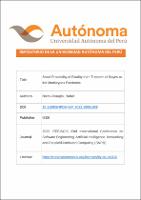| dc.contributor.author | Nieto-Chaupis, Huber | |
| dc.date.accessioned | 2023-10-04T14:49:09Z | |
| dc.date.available | 2023-10-04T14:49:09Z | |
| dc.date.issued | 2022 | |
| dc.identifier.uri | https://hdl.handle.net/20.500.13067/2647 | |
| dc.description.abstract | Why the number of fatalities is very low at the ongoing Monkeypox pandemic, this question can be answered through the theory of Bayes that would anticipate a posterior probability of fatality that applies to the cases of high risk, from a prior probability of infection. The probability of event is derived from the diffusion equation by which is assumed that the infections as well as the associated virus can flux along the continental and intercontinental countries. The resulting probabilities have been small fact that support the idea that the attained diffusion coefficient is large demonstrating that the diffusion is large but the high risk cases are attenuated. | es_PE |
| dc.format | application/pdf | es_PE |
| dc.language.iso | eng | es_PE |
| dc.publisher | IEEE | es_PE |
| dc.rights | info:eu-repo/semantics/restrictedAccess | es_PE |
| dc.rights.uri | https://creativecommons.org/licenses/by-nc-nd/4.0/ | es_PE |
| dc.subject | Pandemics | es_PE |
| dc.subject | Surveillance | es_PE |
| dc.subject | Computational modeling | es_PE |
| dc.subject | Europe | es_PE |
| dc.subject | Solids | es_PE |
| dc.subject | Mathematical models | es_PE |
| dc.subject | Artificial intelligence | es_PE |
| dc.title | Small Probability of Fatality from Theorem of Bayes at the Monkeypox Pandemic | es_PE |
| dc.type | info:eu-repo/semantics/article | es_PE |
| dc.identifier.journal | 2022 IEEE/ACIS 23rd International Conference on Software Engineering, Artificial Intelligence, Networking and Parallel/Distributed Computing (SNPD) | es_PE |
| dc.identifier.doi | https://doi.org/10.1109/SNPD54884.2022.10051808 | |
| dc.subject.ocde | https://purl.org/pe-repo/ocde/ford#2.02.04 | es_PE |
| dc.relation.url | https://ieeexplore.ieee.org/document/10051808 | es_PE |


